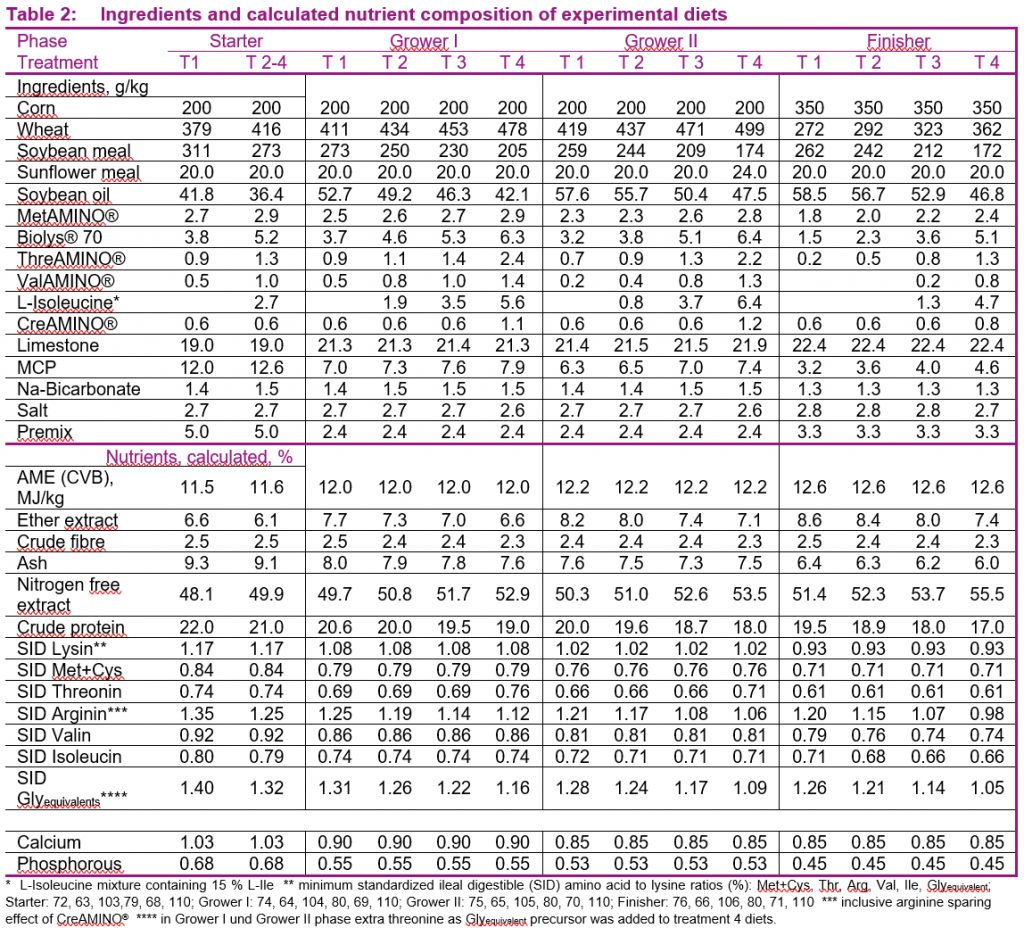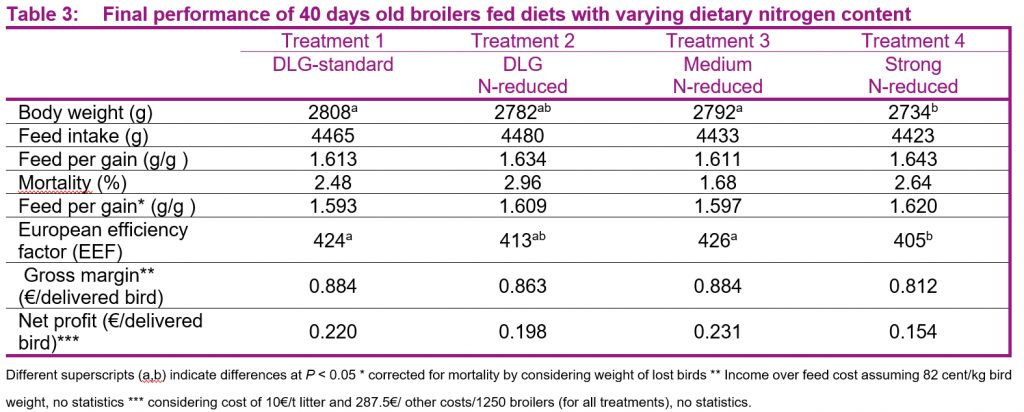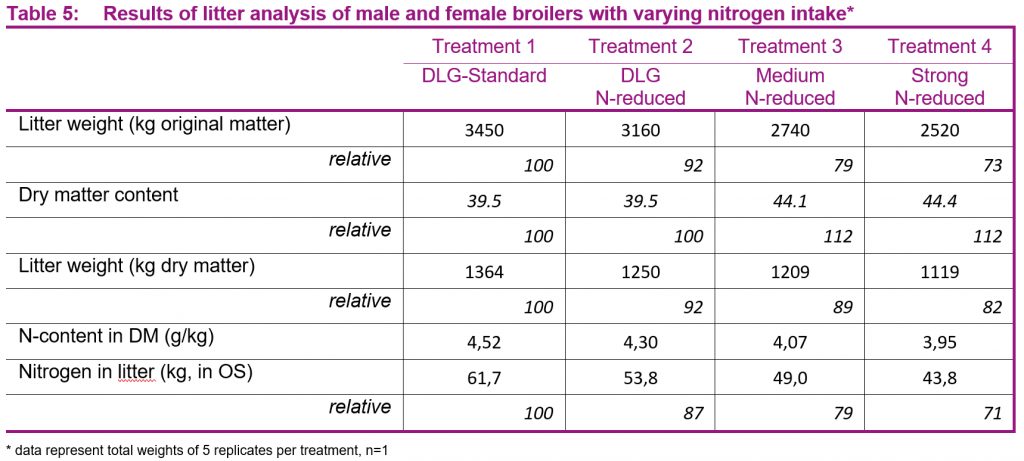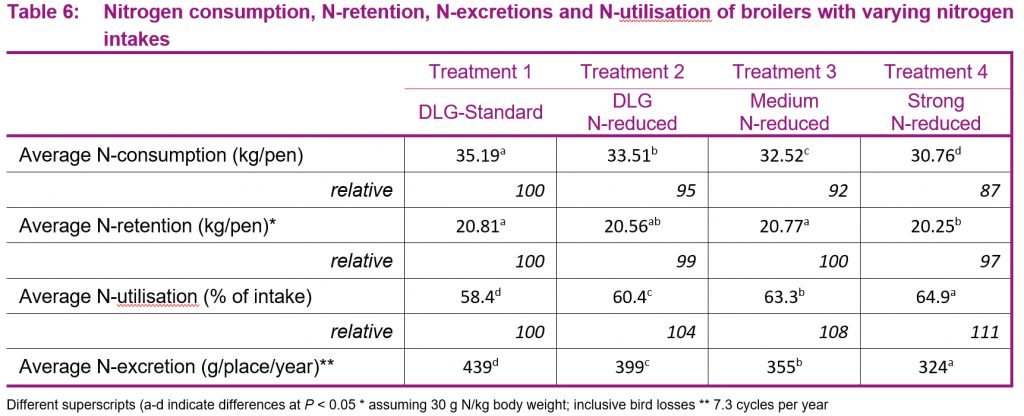Conclusions
- A broiler feeding trial with 4 treatments with decreasing dietary protein levels while maintaining amino acid balance over four feeding phases was conducted.
- Reduction of nitrogen intake by 8 % (treatment 3) did not affect weight gain and feed conversion ratio while nitrogen excretion and litter weight were reduced by 19 % and 21 %, respectively. Percentage of chicken foot pads with no lesions (score 0) almost doubled.
- Reduction of nitrogen intake by 13 % (treatment 4) reduced nitrogen excretion and litter weight even by 26 % and 27 %, respectively. Percentage of chicken foot pads with no lesions were almost tripled compared to standard. However, final body weight and feed conversion impaired by 2.6 % and 1.8 %.
- Carcass evaluation provided indifferent data for male and female birds but indicated that meat deposition might have slightly suffered with protein reduction.
- Reduction of dietary protein (treatments 3 & 4) allowed for meeting legally requested target values for nitrogen excretion.
- Economic calculations confirmed that at least treatment 3 was competitive to the standard feeds but offered advantages concerning environmental and chicken welfare aspects.
Introduction and objective
In Europe, focus on protein nutrition and nitrogen management are of increasing relevance not least because of a European Directive on the reduction of national emissions (European Commission, 2013) concomitant with a Best Available Techniques Reference Document (BAT; Santonja et al., 2017) which set the frame for animal production. The latter document recommends to lower dietary crude protein in animal feed by adding and balancing with supplemental amino acids. There is also increasing pressure from consumers, retailers, food companies and national politics on animal production concerning environmental protection but also concerning animal welfare and animal health management – two aspects where protein nutrition plays a role as well. Moreover, in Germany a revised fertilizing directive as well as a directive on the management of nitrogen and phosphorous at farm level are in force since 2017 (Ministry of Justice and Consumer Protection, 2017a,b). In these documents values for the annual excretion of nitrogen per place and year are suggested which are more ambitious than in the above mentioned BAT paper and which set the basis for nitrogen (and phosphorous) balance calculations on one hand but on other hand also defining maximum excretions allowances. Rough calculations based on key numbers from current broiler feeding practice imply that it will be difficult, if not impossible, to meet those threshold values. Consequently, farmers might be forced to run less cycles per year or reduce animals per sqm. Alternatively, reduction of the dietary protein – as suggested in BAT document – with subsequent reduced nitrogen excretions will be an appropriate strategy.
In a broiler feeding trial initiated by the Chamber of Agriculture, Lower Saxonia, Germany, and executed at the trial facilities of Haus Düsse, North Rhine-Westphalia, Germany, the impact of gradual reduction of dietary protein while balancing for amino acids on growth performance, nitrogen excretion and other criteria was examined.
Material and Methods
A total of 5,000 day-old male and female Ross 308 (41 g/chick) were equally allocated into 20 floor pens with 250 birds each. Temperature program was in line with breeder recommendation whereas the lighting program included two dark periods of 6 and 2 hours per day. Broilers received a standard vaccination program against infectious bronchitis, Newcastle disease, and Gumboro. Floor pens had a size of 17 sqm (15 birds/sqm) and were each equipped with 4 round feeding trough and 20 nipple drinkers for ad libitum consumption of feed and water. For bedding 70 kg straw granules / pen were used and the volume was identical for each pen – there was no extra bedding in any of the pens during course of the experiment. Generally, a 4-phase feeding program was applied comprising a starter (d1-10), a grower I (d11-16), a grower II (d17-30), and a finisher period (d31-40).
The dietary treatments were related to German recommendations by Hiller et al. (2014) as treatment 1 and 2 refer to protein levels of standard feed or feed with reduced nitrogen content. In treatments 3 and 4 nitrogen was reduced to higher degrees as shown in Table 1. Crude protein levels in current German feeding practice are somewhere between treatment 1 and treatment 2. Accordingly, differences in dietary crude protein increased with both age and from treatments 1 to 4. Except for starter diets, there was a good agreement between calculated and analyzed values which also applied for the analyzed amino acid levels.


Wheat-corn-soybean meal based diets were formulated on basis of standardized ileal digestible amino acids (Table 2; Evonik, 2015). Applied essential amino acid ratios to Lys (from Met to Ile) were in line with AMINOChick 2® but SID Lys levels not exactly met recommended 1.27 %, 1.09 %, 0.99 %, and 0.95 %. Findings of a recent European feed survey (Evonik, 2016) were considered and, therefore, SID Lys concentrations were adjusted especially in starter feed. Regarding minimum SID Glyequivalent concentrations minimum ratio to SID Lys of 110 % were chosen referring to least ratios used in successful low protein studies. Although, this ratio may appear low, it was not possible to meet it in the Grower I and Grower II diets of Treatment 4. Therefore, extra L-Thr was added to the diets assuming that 1 kg L-Thr can be converted into 630 g Gly. All diets contained phytase and xylanase but no amino acid releasing impact was considered in feed formulations. Starter and Grower I diets contained nicarbazin and narasin while Grower II contained salinomycin. No coccidiostaticum was put into finisher feeds. Feeds were produced in a commercial feed mill.
Feed consumption was recorded for each phase and pen whereas body weights were determined only at termination at day 40 of the experiment. However, only for one pen per treatment body weights were recorded after 5, 12, 19, 26, 33, and 40 days. Feed conversion ratio (FCR) as well as FCR corrected for mortality (including weight of lost birds) was calculated for the as-hatched flocks. The European Efficiency Factor (EEF) served as economic indicator ([Survival rate, % * final body weight, kg] / [FCR * age, d] * 100). Moreover, net profitability considering diet prices and other cost factors (Damme, 2017) was calculated. After termination of the feeding trial, five male and five female broilers were selected from each pen for carcass evaluation. The goal was to select birds representing the average of the treatment. Weight of breast meat (with skin and bones), legs (drum and thigh) and wings were recorded. Subsequently, carcass yield and yield of breast, leg and wings were calculated. One hundred and twenty chicken feet per treatment were assessed with respect to pododermatitis according a 5-point scoring scale of Hocking et al. (2008; 0 = no lesion, …, 4 = severe lesions). At the end of the experiment, 10 litter samples per pen were taken for analysis of dry matter and nitrogen. Also, the weight of the litter per pen was measured. While respective results allow already for drawing conclusion on ecological impact, nitrogen balance and nitrogen utilization was calculated in addition. For this, 30 g N/kg body weight, was assumed (Hiller et al., 2014).
Data were analysed by one-way ANOVA with subsequent Tukey multiple range test. Pen served as experimental unit for performance and nitrogen balance data. For carcass evaluation, data were analysed separately for male and female birds. In this case individual birds served as experimental unit while covariance analysis (pen) did not reveal significant impact.

Results & Discussion
Performance of broilers is shown in Table 3 and Figure 1. Accordingly, there was only a marginal variation in body weight and feed conversion between treatments 1 to 3 while in treatment 4 performance impaired slightly resulting in 2.6 % lower final weight and 3 %-pts higher FCR. However, compared to Ross 308 performance objectives (2014) for as-hatched broilers, final body weights were about 7 % higher in treatments 1 to 3 and still about 4 % higher in treatment 4. Feed conversion ratios were about 3-5 % below breeder recommendation. Therefore, birds responded excellent to the experimental diets – also to those of treatment 4. Although body weights were recorded after each phase only in one pen per treatment, the growth curves may suggest that birds of treatment 4 fell behind particularly after change to the finisher feed and it might be speculated whether particularly the protein reduction by 2.5 %-pts compared to DLG-standard in treatment 1 was too high or amino acid balancing was not sufficient enough.
The European Efficiency Factor serves as indicator for economic performance of the broilers and it can be seen that birds of treatment 4 achieved the lowest value which is because of both lower final body weight and higher feed conversion ratio (Table 3). The picture does not change when gross margin was calculated by using feed prices according to the feed producer. Diet costs were basically increasing with protein reduction as reduced dietary protein levels had to be forced in by feed formulation program. Only in finisher diets, feed prices were slightly decreasing from treatment 1 to 3 as least cost formulation did not require expensive ingredients to solve the constraints. Only in treatment 4 the finisher diet was more expensive than in treatment 1. Treatments 1 and 3 achieved highest gross margins indicating that degree of protein reduction was indeed sufficient for comparable profit. This was confirmed by a full cost calculation considering various cost positions but also cost for waste management. In our calculation we considered 10 € cost per ton of litter. If cost for waste management would be higher, the positive outcome would even be improved.

Figure 1: Body weight development and feed conversion ratio of one pen of broilers fed Standard DLG diets (Treatment 1), N-reduced DLG diets (Treatment 2), medium N-reduced diets (Treatment 3) and strong N-reduced diets (Treatment 4).
Results of carcass evaluation are shown in Table 4. Accordingly, average body weights of selected male and female broilers were between 70 g (treatment 3) and 100 g (treatment 1) higher than final body weights of all birds (Table 3). In Table 4 data are separated for male and female broilers. Body weights of males of treatment 2 were 106 g or about 3 % lower than those of treatment 1 while they did not further decline with higher dietary CP reduction. Therefore, the body weights of selected broilers did not follow the same trend than final body weights as presented in Table 3. Regarding the females an opposite response could be observed with the selected broilers as birds of treatment 2 were even heavier than those of treatment 1 but in treatments 3 and 4 body weights substantially decreased by about 122 g. This is a remarkable response because one would assume that female broilers would better cope with reduced protein levels as in treatments 3 and 4 but actually the impact on body weights was stronger than that for males. Due to the relative low numbers of animals behind these numbers the following interpretation of carcass data should be taken with caution.

Carcass yields of male broilers showed a similar magnitude of response with highest yield in treatment 1 (71.2 %) and similar yields in the other treatments of about 70.3 %. In females, carcass yield decreased gradually from 71.3 % in treatment 2 to 70.0 % in treatment 4. Expressing breast meat in % of carcass weight, there were almost no differences between the treatments with respect to males except a slightly lower yield in treatment 2. Breast meat yield of females were slightly higher than those of males. However, strongest decline of breast meat yield occurred in treatment 4. Data might suggest that protein reduction affected meat deposition in broilers which would have economic impact. For males one could speculate that especially the protein reduction in the starter diet (same diets for treatments 2 to 4) affected carcass quality but, however, there was no differentiation in body weights across both sexes at this stage. In contrast, female broilers responded particularly in treatments 3 and 4. Body weights achieved with treatment 4 (Table 3) already suggested insufficient nutrient supply while treatment 3 performed well.
Figure 2 on foot pad lesion scoring clearly illustrates the positive impact of dietary protein reduction. While there was basically no significant issue with health of feet, the proportion of feet with no lesion increased up to 71 % in treatment 4. This is certainly related to increased dry matter content as well as to decreased nitrogen content of the litter (Table 5). It was not possible to record water consumption but it is well known that dietary protein content is correlated to water intake and excretion. The latter will influence the dry matter content of the litter. Analyses confirmed that dry matter of litter increased from 39.5 % in treatment 1 to 44.4 % in treatment 4. At the same time the overall volume of litter decreased gradually by up to 27 % in treatment 4 compared to treatment 1. It is emphasized that all pens received the same amounts of bedding material. Furthermore, litter analyses clearly indicated a considerable reduction of nitrogen excretions with dietary protein reduction. The total nitrogen in litter decreased by 13, 21, and 29 % in treatments 2, 3, and 4, respectively, compared to treatment 1. With respect to both waste management and nitrogen management, dietary protein reduction as exercised in the current trial is a powerful tool.

Figure 2: Foot pad lesion scoring (according to Hocking) of 120 feet per treatment of broilers fed diets with decreasing dietary N-intake from treatment 1 (T1) to treatment 4 (T4)*
*There was no lesion score of 4 detected

Complementary to the results of the litter analyses is the nitrogen balance examination (Table 6). The strategies for protein reduction in treatments 2, 3, and 4, allowed for a 5, 8, and 13 % lower nitrogen intake. Due to similar final body weights (even treatment 4 was only 2.6 % behind), there was only little variation in nitrogen retention. Consequently, nitrogen utilization increased gradually and considerable. Already treatment 1 showed a rather high nitrogen utilization of 59.1 % which increased by 5.7 %-pts to 65.8 % in treatment 4. This remarkable improvement shows the power of precision livestock feeding with amino acid balancing. N-balance calculations were in line with recent German directive for fertilization. Assuming typical 7.3 cycles per year (Damme, 2017), annual nitrogen excretions would add up to 439, 399, 354, and 324 g/place/year. The German directive for fertilization assumes or expects 413 g/place/year for standard diets and 385 g/place and year for N-reduced diets which would apply for treatments 1 and 2, respectively. These values were slightly exceeded in the current trial although birds performed very well. From this, it might be concluded that average performance under commercial conditions would result in higher annual nitrogen excretion which would force broiler growers to reduce number of animals per sqm or cycles per year. However, nitrogen excretions of treatments 3 and 4 were well below the target value of 385 g and would thus be an attractive strategy to meet the target settings of the German legislation.

In summary, reduction of nitrogen intake by 8 % (treatment 3) weight gain and feed conversion ratio could be maintained while nitrogen excretion was reduced by 19 %, litter weight was reduced by 21 % and chicken feet with no lesions (score 0) almost doubled. Reduction of nitrogen intake by 13 % (treatment 4) reduced nitrogen excretion and litter weight even by 26 % and 27 %, respectively. Chicken feet with no lesions were almost tripled compared to standard. However, final body weight and feed conversion impaired by 2.6 % and 1.8 %. Carcass evaluation provided indifferent data for male and female birds but indicated that meat deposition might have slightly suffered with protein reduction. Reduction of dietary protein (treatments 3 & 4) allowed for meeting legally requested target values for nitrogen excretion. Finally, economic assessment confirmed that at least treatment 3 was competitive to standard feeds but offered advantages concerning environmental and welfare aspects.
References
Aviagen, 2014, Ross 308 broiler performance objectives, Aviagen Inc. 0814–AVNR-033.
Damme, K., 2017, Faustzahlen zur Betriebswirtschaft, in Geflügeljahrbuch 2018, edt. Damme et al., Ulmer Verlag, Stuttgart, 76-95.
European Commission, 2013, Proposal for a directive of the European Parliament and of the council on the reduction of national emissions of certain atmospheric pollutants and amending Directive 2003/35/EC.
Evonik, 2015, Standardized ileal digestibility of amino acids in broilers, brochure pp 16.
Evonik, 2016, European Broiler Feed Survey 2015, brochure pp 24.
German Federal Ministry of Justice and Consumer Protection, 2017a, Verordnung über die Anwendung von Düngemitteln, Bodenhilfsstoffen, Kultursubstraten und Pflanzenhilfsmitteln nach den Grundsätzen der guten fachlichen Praxis beim Düngen (Düngeverordnung – DüV; Fertilizing directive).
German Federal Ministry of Justice and Consumer Protection, 2017b, Verordnung über den Umgang mit Nährstoffen im Betrieb und betriebliche Stoffstrombilanzen (Stoffstrombilanzverordnung – StoffBilV).
Hiller et al., 2014, Bilanzierung der Nährstoffausscheidungen landwirtschaftlicher Nutztiere (2. Auflage), Band 199, DLG-Verlag GmbH, Frankfurt, Germany, ISBN 978-3-7690-3166-9.
Hocking et al., 2008, Standard European footpad dermatitis scoring system for use in turkey processing plants. World’s Poult. Sci. J. 64, 323 –328.
Santonja et al., 2017, Best Available Techniques (BAT) Reference Document for the Intensive Rearing of Poultry or Pigs, Industrial Emissions Directive 2010/75/EU (Integrated Pollution Prevention and Control), European Commission, ISBN 978-92-79-70214-3.
The content of this document is for the information and assistance of Evonik’s customers and is not applicable to products marketed or sold in the United States. Evonik markets its products in compliance with applicable local laws, but it is the user’s responsibility to ensure that the use of and any claims made for this product comply with all relevant requirements. This document may not be published in the United States without the express written consent of Evonik Operations.